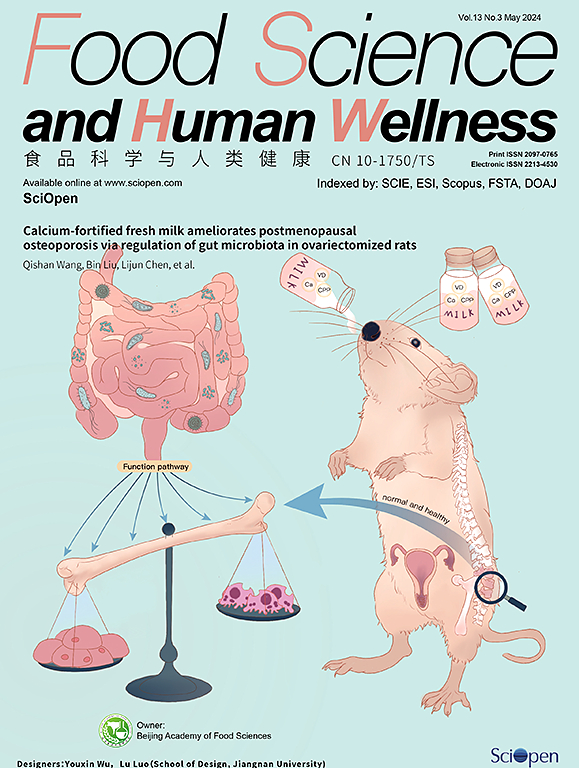Oxidative mechanism of chicken wooden breast myofibrillar protein
IF 7.4
1区 农林科学
Q1 FOOD SCIENCE & TECHNOLOGY
引用次数: 0
Abstract
To explore the oxidation mechanism of wooden breast myofibrillar protein (WBMP), oxidative breast MP (OBMP) was obtained from different doses (3, 10, and 20 mmol/L) of H2O2 oxidized normal breast MP (NBMP). The results showed that the Zeta-potential, particle size, solubility, sulfhydryl, and carbonyl contents of OBMP-3 (3 mmol/L, low-dose free radicals) and WBMP were similar. Fluorescence spectrum analysis showed that the oxidation of low-dose free radicals led to a significant increase in the surface hydrophobicity (from 214.03 ± 10.03 to 393.50 ± 10.33) and tryptophan fluorescence intensity (from 185.71 to 568.32). In addition, the α-helix content of WBMP decreased significantly from (37.46 ± 1.15)% (NBMP) to (34.70 ± 2.04)%, while β-sheet and random coil contents increased significantly (P < 0.05) from (14.37 ± 0.69)% and (22.24 ± 0.78)% (NBMP) to (17.70 ± 0.87)% and (25.20 ± 1.47)% (WBMP). In summary, low-dose free radical oxidation attacks protein groups, inducing secondary and tertiary structural changes, leading to the formation of WBMP. This work will provide a theoretical basis at the molecular level for exploring the mechanism of functional degradation of WBMP.
鸡木胸肌纤维蛋白的氧化机制
为探讨木质乳腺肌原纤维蛋白(WBMP)的氧化机制,采用不同剂量(3、10、20 mmol/L) H2O2氧化正常乳腺MP (NBMP)获得氧化性乳腺MP (OBMP)。结果表明:3 mmol/L、低剂量自由基含量的OBMP-3与WBMP在ζ电位、粒径、溶解度、巯基和羰基含量等方面基本一致;荧光光谱分析表明,低剂量自由基氧化导致表面疏水性(从214.03±10.03增加到393.50±10.33)和色氨酸荧光强度(从185.71增加到568.32)显著增加。此外,WBMP中α-螺旋含量从(37.46±1.15)% (NBMP)显著降低至(34.70±2.04)%,β-片状和随机卷曲含量显著增加(P <;从(14.37±0.69)% 0.05)和(22.24±0.78)% (NBMP)(17.70±0.87)%和(25.20±1.47)% (WBMP)。综上所述,低剂量自由基氧化攻击蛋白质基团,诱导二级和三级结构改变,导致WBMP的形成。本研究将为探索WBMP功能降解机制提供分子水平上的理论基础。
本文章由计算机程序翻译,如有差异,请以英文原文为准。
求助全文
约1分钟内获得全文
求助全文
来源期刊

Food Science and Human Wellness
Agricultural and Biological Sciences-Food Science
CiteScore
8.30
自引率
5.70%
发文量
80
审稿时长
28 days
期刊介绍:
Food Science and Human Wellness is an international peer-reviewed journal that provides a forum for the dissemination of the latest scientific results in food science, nutriology, immunology and cross-field research. Articles must present information that is novel, has high impact and interest, and is of high scientific quality. By their effort, it has been developed to promote the public awareness on diet, advocate healthy diet, reduce the harm caused by unreasonable dietary habit, and directs healthy food development for food industrial producers.
 求助内容:
求助内容: 应助结果提醒方式:
应助结果提醒方式:


